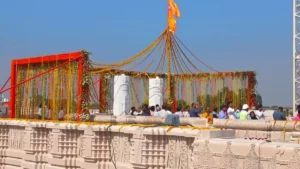Ram Mandir: A Journey Through History, Faith, and Unity

Introduction: Ram Mandir
Ram Janmabhoomi, the revered land in Ayodhya believed to be the birthplace of Lord Rama, is a sacred site that transcends religious and cultural boundaries. The multifaceted history of Ram Janmabhoomi is deeply intertwined with the spiritual beliefs of millions, the complexities of the Ayodhya dispute, and the subsequent legal battles that have shaped the narrative over the years. In this comprehensive blog post, we will embark on a journey through the layers of history, faith, and unity surrounding Ram Janmabhoomi.
Historical Significance: Ram Mandir
The roots of Ram Janmabhoomi extend back to ancient times, finding resonance in the pages of the Ramayana, one of the great epics of Hindu mythology. Authored by the sage Valmiki, the Ramayana recounts the life and divine exploits of Lord Rama, the seventh avatar of Lord Vishnu. Ayodhya, the city where Rama is believed to have taken birth, stands as a testament to the enduring cultural and spiritual heritage of India. The deep-seated belief in the sanctity of this land has been passed down through generations, creating an unbreakable bond between millions of Hindus and the divine aura of Ram Janmabhoomi.
The Ayodhya Dispute: Ram Mandir
The narrative of Ram Janmabhoomi took a tumultuous turn in the latter half of the 20th century with the emergence of the Ayodhya dispute. The Babri Masjid, constructed in the 16th century by Mughal Emperor Babur, was built on the same site that Hindus consider to be the birthplace of Lord Rama. Tensions escalated, leading to a pivotal moment on December 6, 1992, when the Babri Masjid was demolished by a group of Hindu activists. This event had far-reaching consequences, triggering communal tensions and reshaping the socio-political landscape of India.
Legal Battles and Resolutions: Ram Mandir
The aftermath of the Babri Masjid’s demolition saw an intricate legal battle unfold over the ownership of the disputed land. Various stakeholders, representing both Hindu and Muslim interests, presented their claims before the courts. The legal saga reached its zenith in 2019 when the Supreme Court of India delivered a landmark verdict. The court ruled in favor of the construction of a Hindu temple at the disputed site, acknowledging the historical and religious significance attributed to it. Simultaneously, the court directed the government to allocate an alternative plot for the construction of a mosque, emphasizing the importance of maintaining communal harmony.
Cultural and Religious Implications: Ram Mandir
The construction of the Ram Temple at Ram Janmabhoomi holds profound cultural and religious implications for the Hindu community. It symbolizes the realization of a centuries-old dream, a moment of spiritual triumph for millions of devotees. The envisioned temple, designed with intricate architecture, is expected to become not just a place of worship but also a cultural landmark, showcasing India’s rich heritage and religious diversity.
Beyond the religious context, the cultural implications extend to initiatives like the Ayodhya Parikrama Path. This pilgrimage route encompasses significant sites associated with Lord Rama’s life, fostering tourism and providing visitors with a deeper understanding of the cultural tapestry woven around Ayodhya.
Unity and Communal Harmony: Ram Mandir
While the Ayodhya dispute has been a source of tension and division, the construction of the Ram Temple presents an opportunity for fostering unity and communal harmony. Leaders and scholars across religious lines have emphasized the need for mutual respect and understanding. The inclusive approach mandated by the Supreme Court’s verdict reflects a commitment to coexistence, recognizing the diverse fabric of India’s religious landscape.
Conclusion:
Ram Janmabhoomi stands as a testament to the resilience of faith, the complexities of history, and the potential for unity amidst diversity. The journey through the Ayodhya dispute, the legal battles, and the subsequent construction of the Ram Temple exemplify the intricate interplay of religion, culture, and socio-political dynamics in India. As the nation moves forward, it is essential to uphold the principles of religious pluralism, fostering an environment where diverse beliefs coexist harmoniously, and the cultural richness of the nation continues to thrive. Ram Janmabhoomi, with its deep spiritual resonance, serves as a poignant reminder of the enduring power of faith and the potential for unity in the face of historical challenges.
